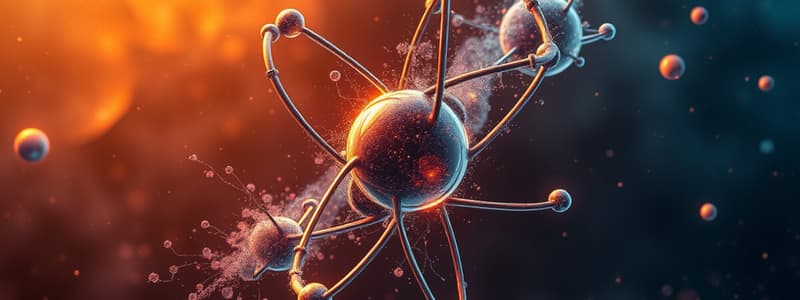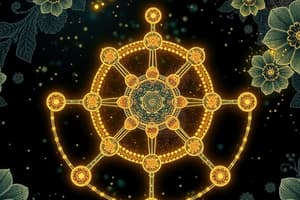Podcast
Questions and Answers
What are the three particles of the atom?
What are the three particles of the atom?
- Nuclei
- Electrons (correct)
- Protons (correct)
- Neutrons (correct)
What are the respective charges of protons, neutrons, and electrons?
What are the respective charges of protons, neutrons, and electrons?
- Negative, positive, neutral
- Positive, neutral, negative (correct)
- Neutral, negative, positive
- Positive, positive, negative
The number of protons in one atom of an element determines the atom's ____
The number of protons in one atom of an element determines the atom's ____
atomic number
The number of electrons determines the _____ of the element.
The number of electrons determines the _____ of the element.
What does the atomic number tell you?
What does the atomic number tell you?
No two different elements will have the same atomic _____
No two different elements will have the same atomic _____
The _______ of an element is the average mass of an element's naturally occurring atoms.
The _______ of an element is the average mass of an element's naturally occurring atoms.
The ______ of an element is the total number of protons and neutrons in the ____ of an atom.
The ______ of an element is the total number of protons and neutrons in the ____ of an atom.
The mass number is used to calculate the number of ____ in one atom of an element.
The mass number is used to calculate the number of ____ in one atom of an element.
To calculate the number of neutrons you must subtract the ____ from the ____.
To calculate the number of neutrons you must subtract the ____ from the ____.
What is the symbol and number of protons in Lithium?
What is the symbol and number of protons in Lithium?
What is the symbol and the number of electrons in a neutral atom of Uranium?
What is the symbol and the number of electrons in a neutral atom of Uranium?
What is the symbol and the number of neutrons in an atom of Barium?
What is the symbol and the number of neutrons in an atom of Barium?
Who confirmed the existence of neutrons?
Who confirmed the existence of neutrons?
Who developed the beginnings of the modern atomic theory in the 1800's?
Who developed the beginnings of the modern atomic theory in the 1800's?
Who first suggested the presence of atoms and named them atomos?
Who first suggested the presence of atoms and named them atomos?
What does STM stand for?
What does STM stand for?
Who used the cathode ray tube to discover electrons?
Who used the cathode ray tube to discover electrons?
Match the following particles with their characteristics:
Match the following particles with their characteristics:
What is the atomic mass equal to?
What is the atomic mass equal to?
What is the atomic number?
What is the atomic number?
What is atomic weight?
What is atomic weight?
If the atom loses electrons, it becomes positively charged.
If the atom loses electrons, it becomes positively charged.
If the atom gains an electron, it becomes negatively charged.
If the atom gains an electron, it becomes negatively charged.
Anything that has ______ and takes up space.
Anything that has ______ and takes up space.
Matter is made of ____.
Matter is made of ____.
All elements are composed of indivisible particles.
All elements are composed of indivisible particles.
Atoms of different ____ are different.
Atoms of different ____ are different.
_______ consisted of atoms of different elements combined together.
_______ consisted of atoms of different elements combined together.
Protons and neutrons have ____ amu mass.
Protons and neutrons have ____ amu mass.
Electrons have ____ amu mass.
Electrons have ____ amu mass.
What element is represented by Au=Periodic abb. 197/79?
What element is represented by Au=Periodic abb. 197/79?
What is the mass number represented as AU197/79?
What is the mass number represented as AU197/79?
What is the atomic number represented as AU197/79?
What is the atomic number represented as AU197/79?
What is the number of protons represented as AU197/79?
What is the number of protons represented as AU197/79?
Flashcards are hidden until you start studying
Study Notes
Basic Atomic Structure
- Atoms consist of three primary particles: protons, neutrons, and electrons.
- Protons carry a positive charge, neutrons are neutral, and electrons have a negative charge.
Atomic Properties
- The number of protons defines an element's atomic number, while the number of electrons determines its electrical charge.
- The atomic number indicates the quantity of protons and electrons in a neutral atom, uniquely identifying elements on the periodic table.
Atomic Weight and Mass Number
- Average atomic weight is the average mass of an element's naturally occurring isotopes, factoring in their abundance.
- The mass number is the total count of protons and neutrons in an atom’s nucleus.
Neutron Calculation
- To determine the number of neutrons, subtract the number of protons from the mass number.
Element Symbols and Atomic Information
- Lithium is represented by the symbol Li and has 3 protons.
- Uranium is denoted by U and has 92 electrons in a neutral atom.
- Barium's symbol is Ba, with 81 neutrons in its nucleus.
Contributors to Atomic Theory
- JJ Thomson is credited with confirming the existence of neutrons.
- James Chadwick contributed to the foundation of modern atomic theory in the 1800s.
- Ernest Rutherford first posited the existence of atoms, calling them "atomos."
- The Scanning Tunneling Microscope (STM) provided the first images of individual atoms.
- Democritus utilized the cathode ray tube to discover electrons.
Electron, Proton, and Neutron Characteristics
- Electrons, negatively charged, orbit outside the nucleus.
- Protons are heavier than electrons and reside in the nucleus.
- Neutrons are also heavier than electrons and are found in the nucleus.
Atomic Fundamentals
- Atomic mass is equivalent to the number of protons within the nucleus.
- Atomic number refers to the proton count in a neutral atom.
- Atomic weight indicates the weight of an atom.
- Ions can be generated when atoms lose electrons (+ions) or gain electrons (-ions).
Matter and Atoms
- Matter is defined as anything with mass that occupies space.
- All objects are composed of atoms, varying in types and combinations.
- Matter can be perceived through senses: sight, taste, smell, and touch.
Atomic Composition
- Elements are made up of indivisible particles, with atoms of the same element being identical.
- Atoms of different elements exhibit distinct characteristics.
- Compounds consist of atoms from different elements combined.
Mass Properties
- Protons and neutrons each have a mass of approximately 1 atomic mass unit (amu).
- Electrons have a negligible mass of approximately 0 amu.
Gold Element Data
- Gold is represented by the symbol Au, with a mass number of 197 and an atomic number of 79.
- The quantity of protons in Gold is also 79.
Studying That Suits You
Use AI to generate personalized quizzes and flashcards to suit your learning preferences.




